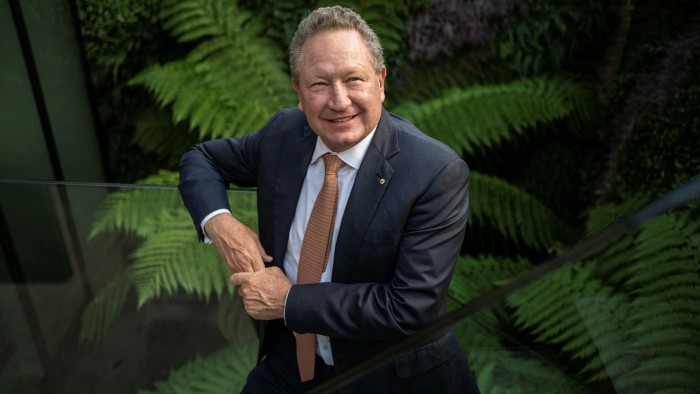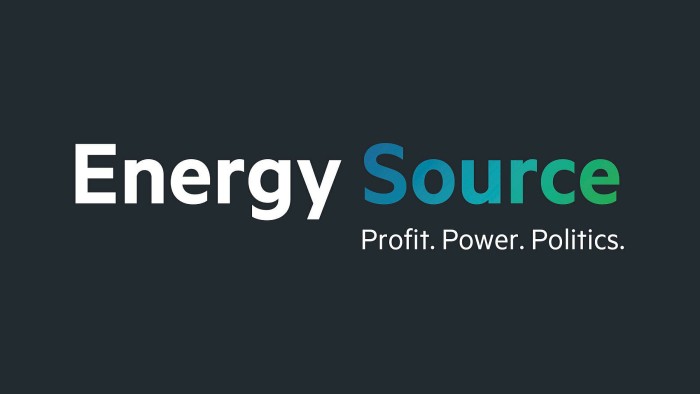Mining mogul Andrew Forrest blasts blue hydrogen ahead of COP26

Roula Khalaf, Editor of the FT, selects her favourite stories in this weekly newsletter.
Billionaire mining mogul Andrew Forrest has slammed the oil industry for promoting hydrogen made from natural gas as a clean fuel, saying that it would unleash more of a potent greenhouse gas into the atmosphere and do nothing to combat climate change.
In an interview ahead of the upcoming UN climate summit in Glasgow, Australia’s second-richest person said that developing so-called blue hydrogen projects would do nothing for the global carbon budget because of fugitive emissions.
“There is a little molecule called methane — it’s 80 to 90 times more potent than carbon,” Forrest said.
The natural-gas industry is among the top causes of methane emissions, which escape during extraction or through leaks in pipelines. The gas is estimated to have contributed to about 30 per cent of the global rise in temperatures to date, according to the International Energy Agency, which sees curbing methane emissions as the most effective means available for limiting global warming in the near term.
Forrest, whose net worth was recently put at more than $20bn by the Australian Financial Review, has described blue hydrogen, which is produced from natural gas and uses carbon capture and storage technology to deal with the emissions, as Big Oil’s “last stand”.
He plans to lobby world leaders at COP26 to adopt a global accreditation system so that only “green” hydrogen, which uses renewable electricity to break the chemical bond between water and hydrogen, can be classed as clean.
“Blue hydrogen does nothing for the carbon budget and that’s if sequestration works,” Forrest told the Financial Times.
His push for a classification system comes as he tries to reinvent Fortescue Metals Group, the mining company he founded and controls through a 36.7 per cent stake, as a green hydrogen company.
He is aiming to produce 15m tonnes of the zero-emission fuel every year by 2030 — 50 per cent more than the EU is targeting by the same date— and will use the gas to decarbonise Fortescue’s operations, sell overseas and also to produce a zero-carbon iron that can be fed directly into furnaces to make fossil-free steel.
Steelmaking is one of the most polluting industrial activities, accounting for up to 9 per cent of all direct fossil fuel emissions, according to the World Steel Association.
FMG operations last year directly released more than 2m tonnes of CO2 equivalent into the atmosphere, mainly through its fleet of diesel-guzzling haul trucks and heavy mining equipment, while the emissions generated by its steelmaking customers were 246m tonnes, roughly equivalent to Spain’s total.
Climate Capital

Where climate change meets business, markets and politics. Explore the FT’s coverage here.
Are you curious about the FT’s environmental sustainability commitments? Find out more about our science-based targets here
Experts say there are significant challenges to overcome before Forrest’s dream can be realised. Among them is the fact that producing green hydrogen is extremely energy intensive, and Fortescue will need to produce at least two to three times Australia’s entire current electricity supply to hit its production targets.
Other big iron ore miners have ruled out following Forrest into hydrogen with the boss of BHP, the world’s biggest miner, telling the FT Mining Summit this month that a push into green hydrogen not be “a good use of shareholder capital.”
Mike Henry said the cost of switching BHP’s operations to the fuel would be “well in excess of its current market cap”, which stands at $140bn.
Forrest is undeterred. FMG this month announced plans to build the world’s largest electrolyser factory in Queensland through its Fortescue Future Industries subsidiary.
Electrolysers split water into its constituent molecules of hydrogen and oxygen. Commenting on the announcement, analysts at RBC Capital Markets said that “project economics, financial metrics and details are light”.
Twice weekly newsletter

Energy is the world’s indispensable business and Energy Source is its newsletter. Every Tuesday and Thursday, direct to your inbox, Energy Source brings you essential news, forward-thinking analysis and insider intelligence. Sign up here.
Forrest, who received $4bn in dividends last year, said he was not reinventing Fortescue to drive up its share price or greenwash a heavy carbon-emitting business.
“You have probably worked out I can feed the kids,” he said. “I fundamentally believe this must be done and as a heavy-emitting . . . company we are in the best position to do it.”
He added: “If you are a large tech company which produces hardly any emissions and wants to go green . . . let’s all clap slowly because you are not doing much for global warming. It is the heavy-emitting sectors . . . that are going to lead us out of global warming.”
As part of our coverage of COP26 we want to hear from you. Do you think carbon pricing is the key to tackling climate change? Tell us via a short survey. We will share some of the most interesting and thought provoking answers in our newsletters or an upcoming story.
Comments